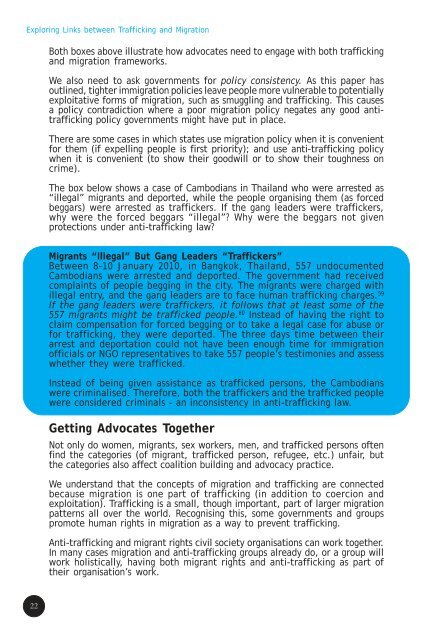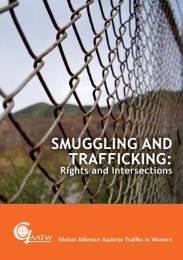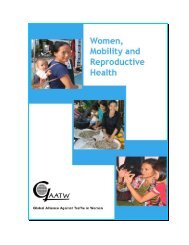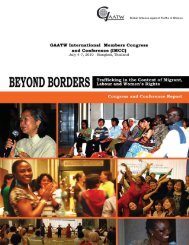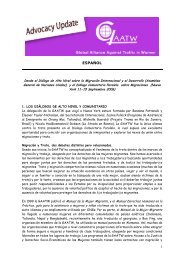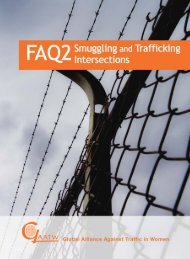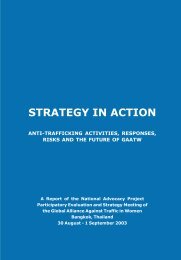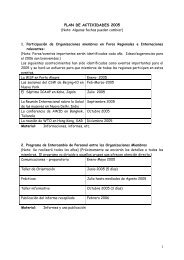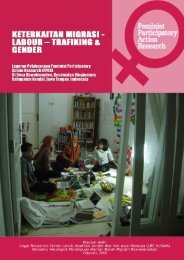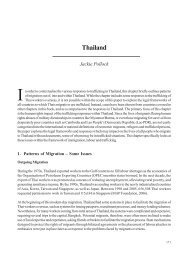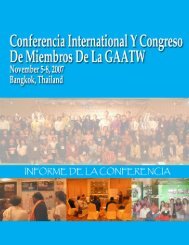Exploring Links between Trafficking and Migration - Global Alliance ...
Exploring Links between Trafficking and Migration - Global Alliance ...
Exploring Links between Trafficking and Migration - Global Alliance ...
- No tags were found...
Create successful ePaper yourself
Turn your PDF publications into a flip-book with our unique Google optimized e-Paper software.
<strong>Exploring</strong> <strong>Links</strong> <strong>between</strong> <strong>Trafficking</strong> <strong>and</strong> <strong>Migration</strong>Both boxes above illustrate how advocates need to engage with both trafficking<strong>and</strong> migration frameworks.We also need to ask governments for policy consistency. As this paper hasoutlined, tighter immigration policies leave people more vulnerable to potentiallyexploitative forms of migration, such as smuggling <strong>and</strong> trafficking. This causesa policy contradiction where a poor migration policy negates any good antitraffickingpolicy governments might have put in place.There are some cases in which states use migration policy when it is convenientfor them (if expelling people is first priority); <strong>and</strong> use anti-trafficking policywhen it is convenient (to show their goodwill or to show their toughness oncrime).The box below shows a case of Cambodians in Thail<strong>and</strong> who were arrested as“illegal” migrants <strong>and</strong> deported, while the people organising them (as forcedbeggars) were arrested as traffickers. If the gang leaders were traffickers,why were the forced beggars “illegal”? Why were the beggars not givenprotections under anti-trafficking law?Migrants “Illegal” But Gang Leaders “Traffickers”Between 8-10 January 2010, in Bangkok, Thail<strong>and</strong>, 557 undocumentedCambodians were arrested <strong>and</strong> deported. The government had receivedcomplaints of people begging in the city. The migrants were charged withillegal entry, <strong>and</strong> the gang leaders are to face human trafficking charges. 59If the gang leaders were traffickers, it follows that at least some of the557 migrants might be trafficked people. 60 Instead of having the right toclaim compensation for forced begging or to take a legal case for abuse orfor trafficking, they were deported. The three days time <strong>between</strong> theirarrest <strong>and</strong> deportation could not have been enough time for immigrationofficials or NGO representatives to take 557 people’s testimonies <strong>and</strong> assesswhether they were trafficked.Instead of being given assistance as trafficked persons, the Cambodianswere criminalised. Therefore, both the traffickers <strong>and</strong> the trafficked peoplewere considered criminals – an inconsistency in anti-trafficking law.Getting Advocates TogetherNot only do women, migrants, sex workers, men, <strong>and</strong> trafficked persons oftenfind the categories (of migrant, trafficked person, refugee, etc.) unfair, butthe categories also affect coalition building <strong>and</strong> advocacy practice.We underst<strong>and</strong> that the concepts of migration <strong>and</strong> trafficking are connectedbecause migration is one part of trafficking (in addition to coercion <strong>and</strong>exploitation). <strong>Trafficking</strong> is a small, though important, part of larger migrationpatterns all over the world. Recognising this, some governments <strong>and</strong> groupspromote human rights in migration as a way to prevent trafficking.Anti-trafficking <strong>and</strong> migrant rights civil society organisations can work together.In many cases migration <strong>and</strong> anti-trafficking groups already do, or a group willwork holistically, having both migrant rights <strong>and</strong> anti-trafficking as part oftheir organisation’s work.22


